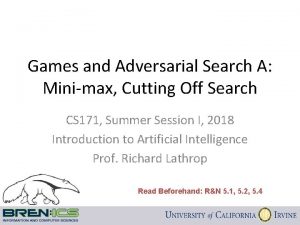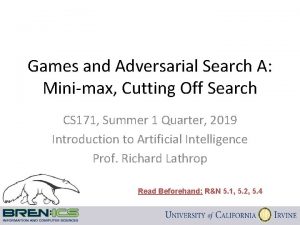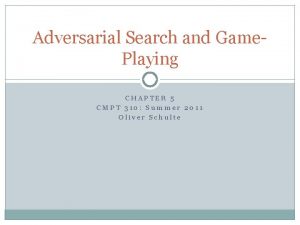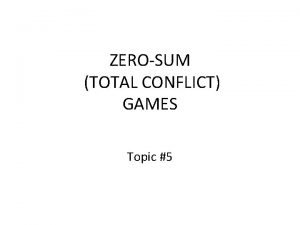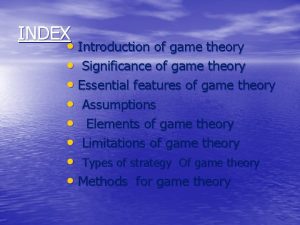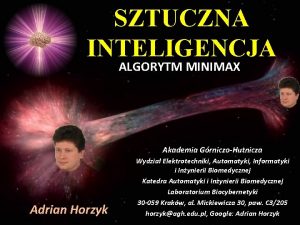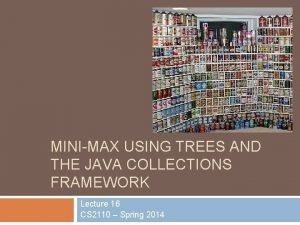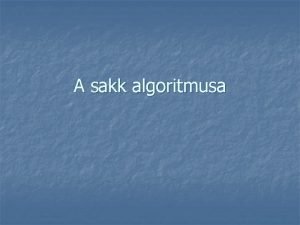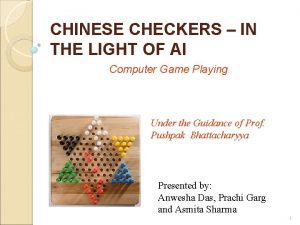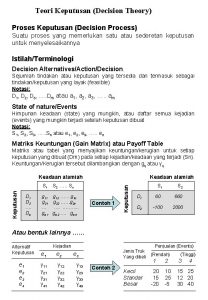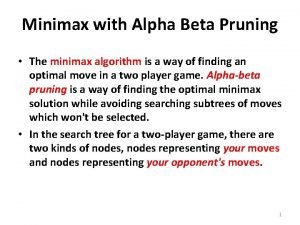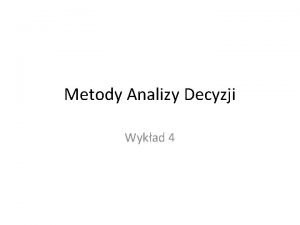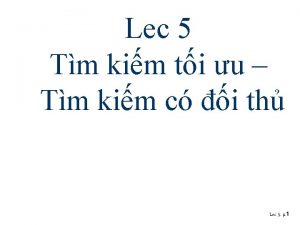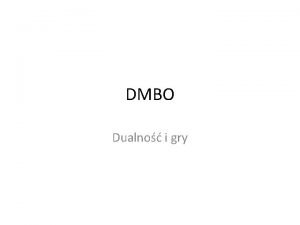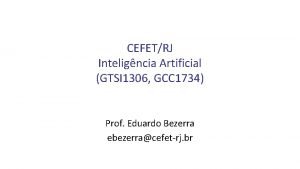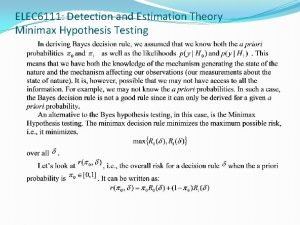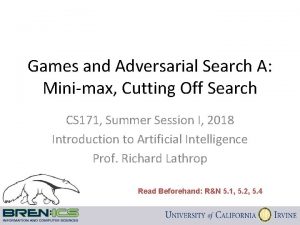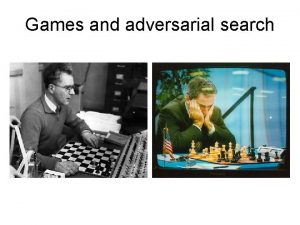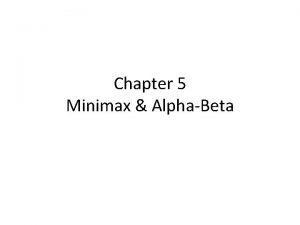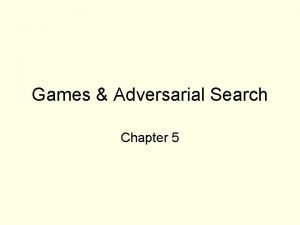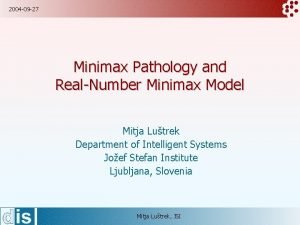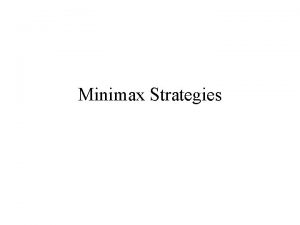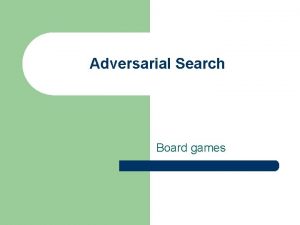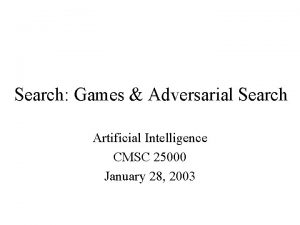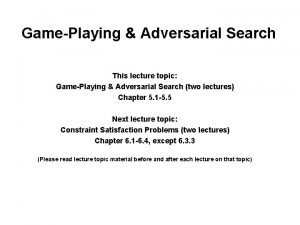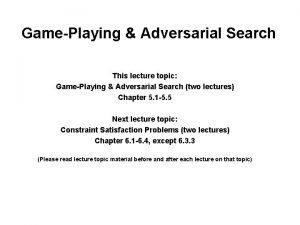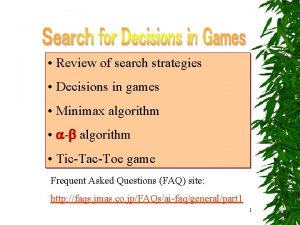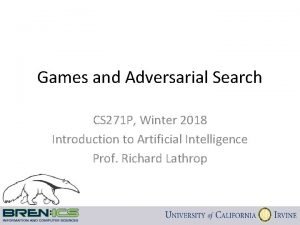Games and Adversarial Search A Minimax Cutting Off

























- Slides: 25

Games and Adversarial Search A: Mini-max, Cutting Off Search CS 271 P, Fall Quarter, 2019 Introduction to Artificial Intelligence Prof. Richard Lathrop Read Beforehand: R&N 5. 1, 5. 2, 5. 4

Outline • Computer programs that play 2 -player games – game-playing as search with the complication of an opponent • General principles of game-playing and search – – – – game tree minimax principle; impractical, but theoretical basis for analysis evaluation functions; cutting off search; static heuristic functions alpha-beta-pruning heuristic techniques games with chance Monte-Carlo ree search • Status of Game-Playing Systems – in chess, checkers, backgammon, Othello, Go, etc. , computers routinely defeat leading world players.

Types of games Deterministic: Chance: Perfect Information: chess, checkers, go, othello backgammon, monopoly Imperfect Information: battleship, Kriegspiel Bridge, poker, scrabble, … • Start with deterministic, perfect information games (easiest) • Not considered: – Physical games like tennis, ice hockey, etc. – But, see “robot soccer, ” http: //www. robocup. org/

Typical assumptions • Two agents, whose actions alternate • Utility values for each agent are the opposite of the other – “Zero-sum” game; this creates adversarial situation • Fully observable environments • In game theory terms: – Deterministic, turn-taking, zero-sum, perfect information • Generalizes: stochastic, multiplayer, non zero-sum, etc. • Compare to e. g. , Prisoner’s Dilemma” (R&N pp. 666 -668) – Non-turn-taking, Non-zero-sum, Imperfect information

Game Tree (tic-tac-toe) • All possible moves at each step • How do we search this tree to find the optimal move?

Search versus Games • Search: no adversary – – – Solution is a path from start to goal, or a series of actions from start to goal Search, Heuristics, and constraint techniques can find optimal solution Evaluation function: estimate cost from start to goal through a given node Actions have costs (sum of step costs = path cost) Examples: path planning, scheduling activities, … • Games: adversary – Solution is a strategy • Specifies move for every possible opponent reply – Time limits force an approximate solution – Evaluation function: evaluate “goodness” of game position – Examples: chess, checkers, Othello, backgammon, Go

Games as search • Two players, “MAX” and “MIN” • MAX moves first, and they take turns until game is over – Winner gets reward, loser gets penalty – “Zero sum”: sum of reward and penalty is constant • Formal definition as a search problem: – – – Initial state: set-up defined by rules, e. g. , initial board for chess Player(s): which player has the move in state s Actions(s): set of legal moves in a state Result(s, a): transition model defines result of a move Terminal-Test(s): true if the game is finished; false otherwise Utility(s, p): the numerical value of terminal state s for player p • E. g. , win (+1), lose (-1), and draw (0) in tic-tac-toe • E. g. , win (+1), lose (0), and draw (1/2) in chess • MAX uses search tree to determine “best” next move

Min-Max: an optimal procedure • Finds the optimal strategy or next best move for MAX: • Optimal strategy is a solution tree Brute Force: 1. Generate the whole game tree to leaves 2. Apply utility (payoff) function to leaves 3. Back-up values from leaves toward the root: • a Max node computes the max of its child values • a Min node computes the min of its child values 4. At root: choose move leading to the child of highest value Minimax: Search the game tree using DFS to find the value (= best move) at the root

Two-ply Game Tree The minimax decision MAX MIN 3 3 3 12 2 2 8 2 4 6 14 5 2 Minimax maximizes the utility of the worst-case outcome for MAX

Recursive min-max search min. Max. Search(state) Simple stub to call recursion f’ns return argmax( [ min. Value( apply(state, a) ) for each action a ] ) max. Value(state) if (terminal(state)) return utility(state); v = -infty for each action a: v = max( v, min. Value( apply(state, a) ) ) return v min. Value(state) if (terminal(state)) return utility(state); v = infty for each action a: v = min( v, max. Value( apply(state, a) ) ) return v If recursion limit reached, eval position Otherwise, find our best child: If recursion limit reached, eval position Otherwise, find the worst child:

Properties of minimax • Complete? Yes (if tree is finite) • Optimal? – Yes (against an optimal opponent) – Can it be beaten by a suboptimal opponent? (No – why? ) • Time? O(bm) • Space? – O(bm) (depth-first search, generate all actions at once) – O(m) (backtracking search, generate actions one at a time)

Game tree size • Tic-tac-toe – B ≈ 5 legal actions per state on average; total 9 plies in game • “ply” = one action by one player; “move” = two plies – – 59 = 1, 953, 125 9! = 362, 880 (computer goes first) 8! = 40, 320 (computer goes second) Exact solution is quite reasonable • Chess – – b ≈ 35 (approximate average branching factor) d ≈ 100 (depth of game tree for “typical” game) bd = 35100 ≈ 10154 nodes!!! Exact solution completely infeasible It is usually impossible to develop the whole search tree.

Cutting off search • One solution: cut off tree before game ends • Replace – Terminal(s) with Cutoff(s) – Utility(s, p) with Eval(s, p) – e. g. , stop at some max depth – estimate position quality • Does it work in practice? – – – bm ≈ 106, b ≈ 35 → m ≈ 4 4 -ply look-ahead is a poor chess player 4 -ply ≈ human novice 8 -ply ≈ typical PC, human master 12 -ply ≈ Deep Blue, human grand champion Kasparov 3512 ≈ 1018 (Yikes! but possible, with other clever methods)

Static (Heuristic) Evaluation Functions • An Evaluation Function: – Estimate how good the current board configuration is for a player. – Typically, evaluate how good it is for the player, and how good it is for the opponent, and subtract the opponent’s score from the player’s. – Often called “static” because it is called on a static board position – Ex: Othello: Number of white pieces - Number of black pieces – Ex: Chess: Value of all white pieces - Value of all black pieces • Typical value ranges: [ -1, 1 ] (loss/win) or [ -1 , +1 ] or [ 0 , 1 ] • Board evaluation: X for one player => -X for opponent – Zero-sum game: scores sum to a constant


Applying minimax to tic-tac-toe • The static heuristic evaluation function: – Count the number of possible win lines O X X O X has 6 possible win paths X has 4 possible wins O has 6 possible wins X has 5 possible wins O has 4 possible wins E(n) = 4 – 6 = -2 E(n) = 5 – 4 = 1 O O has 5 possible win paths E(s) = 6 – 5 = 1

Minimax values (two ply)

Minimax values (two ply)

Minimax values (two ply)


Iterative deepening • In real games, there is usually a time limit T to make a move • How do we take this into account? • Minimax cannot use “partial” results with any confidence, unless the full tree has been searched – Conservative: set small depth limit to guarantee finding a move in time < T – But, we may finish early – could do more search! • In practice, iterative deepening search (IDS) is used – IDS: depth-first search with increasing depth limit – When time runs out, use the solution from previous depth – With alpha-beta pruning (next), we can sort the nodes based on values from the previous depth limit in order to maximize pruning during the next depth limit => search deeper!

Limited horizon effects • The Horizon Effect – Sometimes there’s a major “effect” (such as a piece being captured) which is just “below” the depth to which the tree has been expanded. – The computer cannot see that this major event could happen because it has a “limited horizon”. – There are heuristics to try to follow certain branches more deeply to detect such important events – This helps to avoid catastrophic losses due to “short-sightedness” • Heuristics for Tree Exploration – – Often better to explore some branches more deeply in the allotted time Various heuristics exist to identify “promising” branches Stop at “quiescent” positions – all battles are over, things are quiet Continue when things are in violent flux – the middle of a battle

Selectively deeper game trees 4 MAX (Computer’s move) MIN (Opponent’s move) 3 4 8 5 3 5 4 0 5 0 7 7 8

Eliminate redundant nodes • On average, each board position appears in the search tree approximately 10150 / 1040 ≈ 10100 times – Vastly redundant search effort • Can’t remember all nodes (too many) – Can’t eliminate all redundant nodes • Some short move sequences provably lead to a redundant position – These can be deleted dynamically with no memory cost • Example: 1. P-QR 4; 2. P-KR 4 leads to the same position as 1. P-QR 4 P-KR 4; 2. P-KR 4 P-QR 4

Summary • Game playing as a search problem • Game trees represent alternate computer / opponent moves • Minimax: choose moves by assuming the opponent will always choose the move that is best for them – Avoids all worst-case outcomes for Max, to find the best – If opponent makes an error, Minimax will take optimal advantage (after) & make the best possible play that exploits the error • Cutting off search – – In general, it’s infeasible to search the entire game tree In practice, Cutoff-Test decides when to stop searching Prefer to stop at quiescent positions Prefer to keep searching in positions that are still in flux • Static heuristic evaluation function – Estimate the quality of a given board configuration for MAX player – Called when search is cut off, to determine value of position found
 Cutting off search
Cutting off search Cutting off search
Cutting off search Adversarial search problems uses
Adversarial search problems uses How to identify mesial and distal gmt
How to identify mesial and distal gmt Cutting instruments in operative dentistry
Cutting instruments in operative dentistry Non cutting dental instruments
Non cutting dental instruments Marking tools in sewing
Marking tools in sewing Flank wear
Flank wear Outdoor games and indoor games
Outdoor games and indoor games Minimax and maximin principle in game theory
Minimax and maximin principle in game theory Here b is
Here b is The hunger games discussion questions for chapter 4
The hunger games discussion questions for chapter 4 Elbows off the table fingers off the food song
Elbows off the table fingers off the food song Horzyk agh
Horzyk agh Minimax
Minimax Minimax java
Minimax java Minimax elv
Minimax elv Minimax tv
Minimax tv Computer chinese checkers
Computer chinese checkers Contoh soal decision tree
Contoh soal decision tree Minimax alpha beta pruning
Minimax alpha beta pruning Heurystyka rozpoznawalności
Heurystyka rozpoznawalności Giải thuật minimax
Giải thuật minimax Minimax maximin
Minimax maximin Poda
Poda Minimax
Minimax
